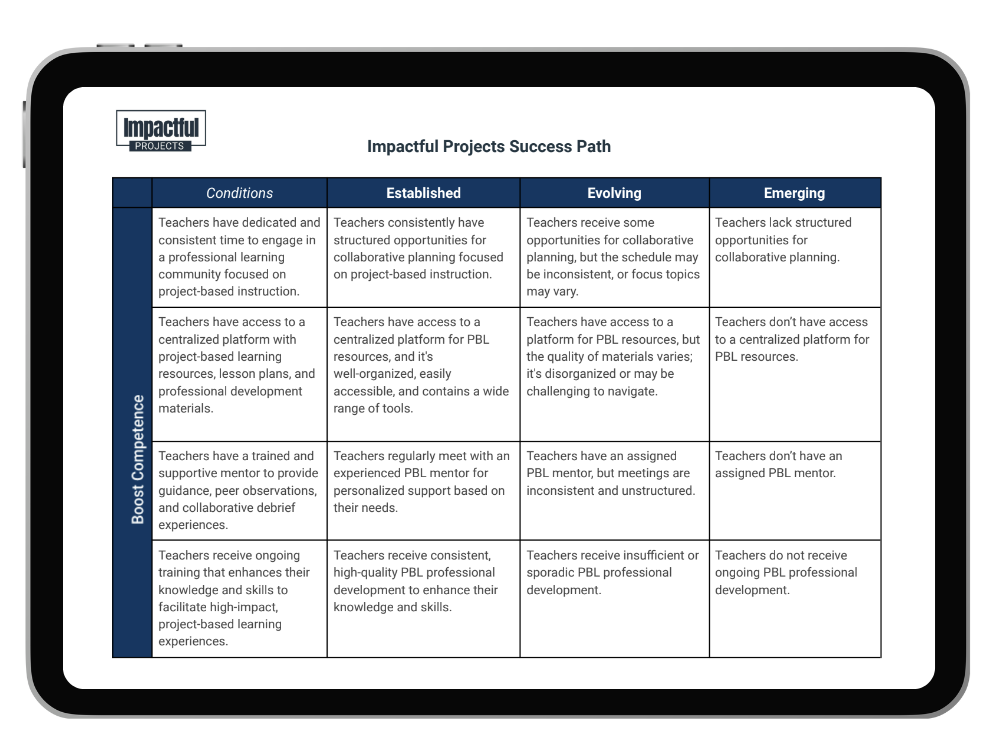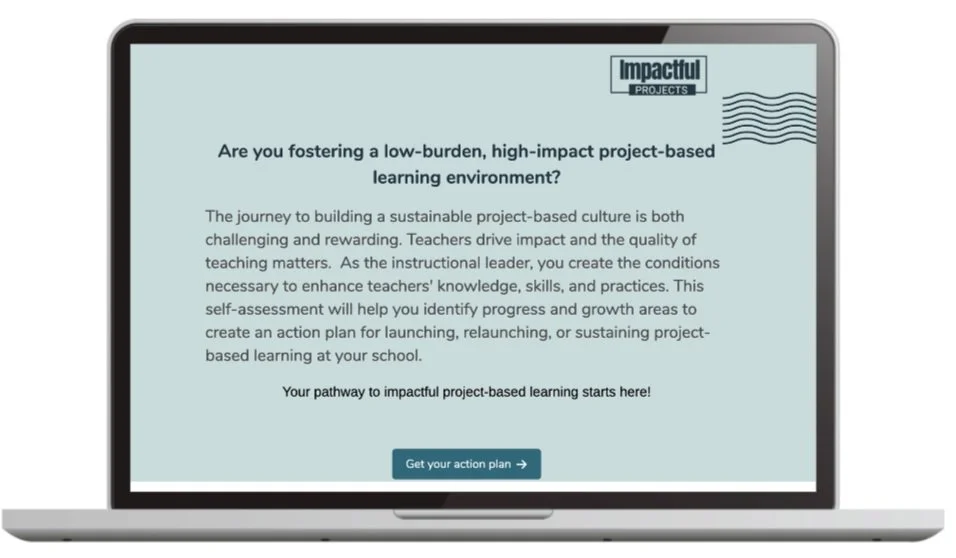Sustaining Project-Based Learning: Building capacity
The previous article explored the importance of boosting teachers' competence and confidence to foster high-impact, project-based learning experiences. Quality professional learning experiences will boost teachers' confidence, thus increasing the likelihood of utilizing project-based core practices in their classes. Project-based learning allows students to engage in real-world, inquiry-based learning and improve academic growth. Let's explore the third necessary component: building capacity.
The success of project-based learning initiatives depends on initial implementation and teachers' sustaining project-based instructional practices over time. School leaders play a crucial role in this process by creating the necessary support structures for teachers. Teachers must maintain ongoing support and structures to sustain PBL at their school site.
🎧 Do you prefer to listen to this article instead?
We often hear the word "capacity building" in education, but what does that mean?
Capacity building is an intervention that strengthens an organization's ability to fulfill its mission or goals sustainably. These interventions include enhancing individuals' abilities, resources, and skills to perform tasks effectively. For example, if a school desires to build a project-based culture, certain enabling conditions must be present to develop and sustain this goal. The challenge is figuring out how to create these conditions to launch a successful project-based learning initiative and then how to maintain this effort beyond one school year.
It's essential to acknowledge and address common roadblocks.
You now understand that building a sustainable, high-impact, project-based culture is challenging and rewarding. School or district leaders encounter three primary roadblocks when launching a project-based learning (PBL) initiative: lack of clarity, competence, and capacity.
Acknowledging potential roadblocks and taking proactive steps to overcome them can foster a community of highly skilled project-based teachers who provide students with transformative learning experiences.
Teachers drive impact, and the quality of teaching matters. However, instructional leaders must create the conditions necessary to enhance teachers' ability to enact the core practices of project-based instruction.
Knowing what conditions you need to foster to produce high-impact project-based educators can be challenging. Or you may know the necessary conditions but need help determining what to focus on and in what order. That answer depends on your current situation. Go back to your vision for PBL and review the reflection notes you completed during the previous articles to determine where you are now. You likely notice a gap between your current and desired state. How do you close that gap?
Use these three Impactful Projects’ tools to guide you through your journey.
I created three tools to guide you through the process. The first is the Impactful Projects Success Path, a rubric that describes the phases of a project-based learning initiative and the enabling conditions necessary to achieve each level. The Path outlines the key conditions leaders need to establish to set their teachers up for success.
This rubric isn't just a checklist; it's a guiding framework that helps leaders assess their readiness across three levels: emerging, evolving, and established. Each level represents a stage of preparedness, from laying the groundwork to reaching a state of sustainable excellence in project-based learning implementation.
Resource #1: The Impactful Projects Success Path
I will provide a brief overview of the rubric, but it's more beneficial for you to download and examine it.
The top row of the rubric lists the ratings or phases aligned to each enabling condition. Emerging is equivalent to phase one, evolving would be phase two, and established would be the final phase. The far left column lists the three overarching enabling conditions I introduced in previous articles: gaining clarity, boosting competence, and building capacity. Under each of the overarching conditions, there are nine specific actions that instructional leaders should ensure teachers possess to foster a project-based culture at their school site.
While rubrics can be great, sometimes it's still challenging to know exactly how to rate yourself, especially when results fall between multiple levels. While a rubric is supposed to make assessing progress easier without norming, it can become subjective. When I began my role as an instructional coach for a teacher preparation program, we spent hours in what they called "norming sessions." Instructional coaches would gather, watch a teacher deliver a lesson, rate the teacher's effectiveness using a rubric, and then compare ratings. The idea was that we should all assign the same rating if we internalized the rubric similarly.
Resource #2: The Impactful Projects Readiness Assessment
You most likely don't have hours to orchestrate norming sessions, so I created the Impactful Projects Readiness Assessment. In five minutes, you can answer a few multiple-choice questions and receive a personalized level of readiness. It's a powerful tool that helps instructional leaders utilize the success path or rubric, allowing them to identify successes and areas for growth.
By reflecting on your strengths and areas for improvement, you can chart a clear path forward. The self-assessment is a catalyst for action. Instructional leaders can use these results to complete the Impactful Projects Map. This guide outlines concrete tasks and strategies to propel you to take action toward the next level of readiness.
Resource #3: The Impactful Projects Readiness
Success Map
Using the results from the Impactful Projects Readiness Assessment, download the Impactful Project Success Map to create a customized plan of action. For each enabling condition, acknowledge your strengths by placing a checkmark next to the tasks you already completed. For incomplete tasks, create a plan of action by assigning responsible parties and deadlines to ensure implementation.
These three resources can be your compass to a project-based culture.
Why are these resources so crucial? Let's go back to our journey analogy. Imagine getting in a car without a clear destination. You want to visit the beach but don't know which beach, how to get there, or where you will stay when you arrive. You just know you want a nice vacation at the beach. Your dream vacation most likely won't become a reality without a confirmed destination and a map or GPS. You may encounter unexpected roadblocks, dead-end streets, and detours that will make your journey unpleasant.
The Impactful Projects Success Map and readiness self-assessment serve as the itinerary for launching a successful project-based learning initiative. But it's not just about having a plan; it's about fostering a culture of continuous improvement. The Impactful Projects Map describes your actions to reach your desired outcome- in this case, a high-impact, sustainable project-based culture.
Using these three tools iteratively allows you to monitor your team's progress, adapt to challenges, and refine your approach over time. This iterative process is critical to sustaining long-term success in project-based learning.
Enact these practical tips to leverage these resources
Now, let's talk about practical tips for leveraging these resources effectively. First, it's essential to approach the rubric and readiness self-assessment with an open mind and a spirit of collaboration. Engage your team in the process, solicit feedback, and leverage the collective expertise of your staff.
Secondly, refrain from viewing the results as a pass or fail or viewing it on a good or bad spectrum. Instead, see the level of readiness as a starting point for growth. Celebrate your successes, but also embrace areas where you can improve. Remember, every journey begins with a single step, and every improvement brings you closer to your goals, no matter how small.
Lastly, use the Impactful Projects Map or action plan as your guide. Break down large tasks into manageable steps, set realistic timelines, and hold yourself and the leaders of each task accountable. Don't be afraid to seek support along the way. Whether through professional development opportunities, mentorship, or peer collaboration, leverage all available resources to fuel your progress.
Take action:
Step 1). Take the Impactful Projects Readiness self-assessment to determine the phase of your PBL initiative: emerging, evolving, or established.
Step 2). Using the self-assessment results, view the Impactful Projects Success Path to discover the enabling conditions necessary to achieve the next level.
Step 3). Complete the Impactful Projects Success Map with your instructional leadership team to determine where you need to gain clarity, boost competence, and build capacity.
Determine which tasks are necessary to create the enabling conditions for teachers and then decide who will lead each task. Set a deadline for completion. You will have an implementation plan when you complete the Impactful Projects Success Map.
I recognize that schools have various structures for instructional leadership. For step 3, if you are an instructional coach or grade-level chair, a leadership team for you would include inviting the administration to help create an action plan. Or vice versa, if you are the principal or assistant principal, ask instructional coaches or teacher leaders to assist with step 3.


